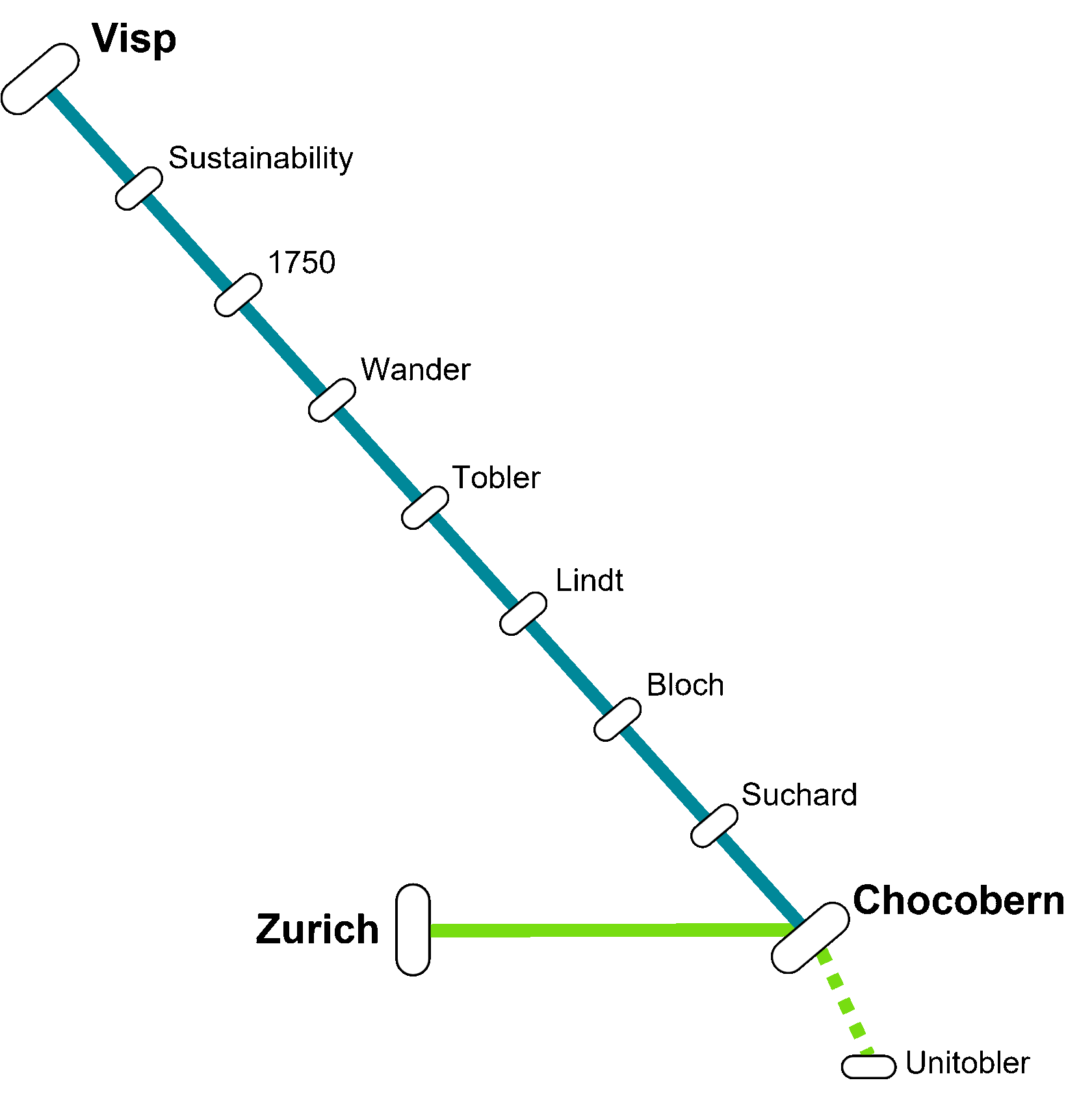CHOCO-Express
Tilda Publishing
Route map

Visp
Welcome to the website of the CHOCO-Express. The route map in your box serves as an orientation guide for the journey through Bern's chocolate history, which is summarized and illustrated on this website. In the box you will also find chocolates from Casa Nobile. At the latest when you arrive at the final destination, you will learn more about myself and the Swiss chocolate capital: I wish you an enjoyable stay aboard of the CHOCO-Express!
Casa Nobile is a manufactory from Bätterkinden in the canton of Bern. Since 2005, they have been producing chocolates by hand in the former star restaurant Krone (Crown). Today Casa Nobile is considered the best chocolatier in Switzerland and all their chocolates are made from cocoa for which at least the Fair Trade Price was paid.
Choba Choba is another chocolate maker from Bern, which was established in 2015 as a result of a fair trade project. Cocoa farmers from Peru are financially participating in the company. Their plantations are in the Alto Huayabamba Valley of the Peruvian Amazon and their cacao is called Oswaldo.
Casa Nobile is a manufactory from Bätterkinden in the canton of Bern. Since 2005, they have been producing chocolates by hand in the former star restaurant Krone (Crown). Today Casa Nobile is considered the best chocolatier in Switzerland and all their chocolates are made from cocoa for which at least the Fair Trade Price was paid.
Choba Choba is another chocolate maker from Bern, which was established in 2015 as a result of a fair trade project. Cocoa farmers from Peru are financially participating in the company. Their plantations are in the Alto Huayabamba Valley of the Peruvian Amazon and their cacao is called Oswaldo.

Quadretti of Casa Nobile in colaboration with Choba Choba
For the tasting you will find in your box the following chocolates:
1) Dark chocolate with nut brittle & maldon salt;
2) Blonde chocolate with almonds & passion fruit;
3) Dark chocolate made of the Oswaldo cocoa from Choba Choba with oranges and ginger
4) Milk chocolate with Italian hazelnuts (Piemont).
Allergens: Nuts such as pistachios, almonds and hazelnuts, vanilla, milk, butterfat, soy, kampot pepper and sugar.
1) Dark chocolate with nut brittle & maldon salt;
2) Blonde chocolate with almonds & passion fruit;
3) Dark chocolate made of the Oswaldo cocoa from Choba Choba with oranges and ginger
4) Milk chocolate with Italian hazelnuts (Piemont).
Allergens: Nuts such as pistachios, almonds and hazelnuts, vanilla, milk, butterfat, soy, kampot pepper and sugar.
▼
Sustainability
Fair Trade is intended to counteract the trade-off between profit and a fair distribution of salaries along the supply chain. In addition to Choba Choba, Fairafric should also be mentioned: Hendrik Reimers from Germany produces chocolate in Ghana with his local team. This means that an important part of the added value is created in the country of the cocoa farmers.
The cocoa plant (Theobroma Cacao) grows in the areas around the equator. Unfortunately, it is a fact that international sea law blocks the enforcement of more climate-friendly propulsion systems for cargo ships. For this reason, the transportation of cocoa has a negative effect on the climate.
Having been to Africa for a development project prior to setting up Chocobern, I recommend when faced with the dilemma between climate neutrality and a guaranteed income for cocoa farmers:
Pay attention to the price when buying! Cheap chocolate never guarantees fair wages in the country of origin of the cocoa. Prefer to buy chocolate with a fair-trade-label, which costs more. The higher price will limit your consumption. However, the more expenisve chocolate retains its main characteristic as a luxury food and this will ultimately increase your moment of pleasure!
The cocoa plant (Theobroma Cacao) grows in the areas around the equator. Unfortunately, it is a fact that international sea law blocks the enforcement of more climate-friendly propulsion systems for cargo ships. For this reason, the transportation of cocoa has a negative effect on the climate.
Having been to Africa for a development project prior to setting up Chocobern, I recommend when faced with the dilemma between climate neutrality and a guaranteed income for cocoa farmers:
Pay attention to the price when buying! Cheap chocolate never guarantees fair wages in the country of origin of the cocoa. Prefer to buy chocolate with a fair-trade-label, which costs more. The higher price will limit your consumption. However, the more expenisve chocolate retains its main characteristic as a luxury food and this will ultimately increase your moment of pleasure!
▼
1750
Mill of Schermen

The municipality of Ittigen is located in the northeast of Bern City (www.swisstopo.admin.ch)
2 pioneers from the Lombardy processed cocoa into a type of chocolate in the Mill of Schermen. The mill was in the municipality of Ittigen, which is bordering the city of Bern.
This is the oldest documented chocolate production in Switzerland. Therefore, as long as no older documents are found, it may be claimed that not only the Bernese, but also the Swiss chocolate have their origin in this mill near Bern.
In consequence, Switzerland owes its chocolate to the Italian know-how of these 2 unknown pioneers!
This is the oldest documented chocolate production in Switzerland. Therefore, as long as no older documents are found, it may be claimed that not only the Bernese, but also the Swiss chocolate have their origin in this mill near Bern.
In consequence, Switzerland owes its chocolate to the Italian know-how of these 2 unknown pioneers!
▼
Wander
Ovomaltine® or in English Ovaltine®
▼
Tobler
Toblerone®
▼
Lindt
Melting Chocolate
What is meant by conching? Cocoa beans are very greasy and as a plant, they also contain water. Fat and water were the problem in cocoa processing, for which Lindt found a mechanical solution: First, the cocoa beans must be fermented, roasted, shelled, refined and mixed up with sugar...
Then the cocoa mass goes into the conching machine. There it must be gently heated by being rolled for hours. This allows water to evaporate without the sugar crystallizing. Finally, the reduction of water enables a chemical fusion of the elements, which gives the chocolate its homogeneous structure.
In order for the chocolate to melt in the mouth, cocoa butter must also be added to the mass during the conching process. To obtain cocoa butter, the beans are squeezed (de-oiling of the cocoa bean was a patent of the Dutchman Van Houton).
Then the cocoa mass goes into the conching machine. There it must be gently heated by being rolled for hours. This allows water to evaporate without the sugar crystallizing. Finally, the reduction of water enables a chemical fusion of the elements, which gives the chocolate its homogeneous structure.
In order for the chocolate to melt in the mouth, cocoa butter must also be added to the mass during the conching process. To obtain cocoa butter, the beans are squeezed (de-oiling of the cocoa bean was a patent of the Dutchman Van Houton).
Model of the original conching machine of Rudolf Lindt, which was operated by a water wheel (real dimensions: 3m in length, 2m in width and height).
▼
Bloch
Ragusa®
▼
Suchard
Apprenticeship in Bern and Milka®
▼
Chocobern
Chocolate Capital

Chocobern next to the former Lindt factory in Bern (photo by D. Bill)
My name is Felix and as a food lover as well as a nostalgic person, at least I am convinced that Bern was once a chocolate capital. In an effort to provide public access to this cultural heritage, I developed the tours of Chocobern in 2019.
Although Chocobern is still a one-man show, I am convinced that it will one day create jobs in the spirit of social entrepreneurship. Ideally, a chocolate production can be realized which is openly designed so that the public can watch how chocolate is made. In this way, the production also takes on the function of a chocolate museum. More about this project can be found here: Magdas-Project-II.
At this point I would like to highlight the following: We all owe the chocolate finally to the person in Central/South America who first risked eating the cacao fruit together with the seeds and who then became delighted by the bitter aromas of the seeds. This was without question the most delicious discovery since humans have existed!
Although Chocobern is still a one-man show, I am convinced that it will one day create jobs in the spirit of social entrepreneurship. Ideally, a chocolate production can be realized which is openly designed so that the public can watch how chocolate is made. In this way, the production also takes on the function of a chocolate museum. More about this project can be found here: Magdas-Project-II.
At this point I would like to highlight the following: We all owe the chocolate finally to the person in Central/South America who first risked eating the cacao fruit together with the seeds and who then became delighted by the bitter aromas of the seeds. This was without question the most delicious discovery since humans have existed!
►
Unitobler
The former Tobler factory is today part of the University of Bern

Picture of the Tobler factory (Berner Zeitschrift für Geschichte und Heimatkunde)
The building is in the Länggasse district, which is situated in the northern part of the city. Until 1985, the Tobler factory was in this building. In 1993 the former factory building of Tobler became a site of the University of Bern.
In the past, the area of Länggasse was one of the industrial districts of the city. As various working settlements were formed around the factories, the neighborhood quickly developed into a residential district as well.
The many Italian restaurants in the neighborhood are still a reminder that many of the workers came originally from Italy. With a flashback to the year 1750, a colorful bow can be drawn here wonderfully, because Switzerland owes not only chocolate, but many other important things to foreign cultures!
Finally, I would like to thank you for your interest and wish you a beautiful continuation of your stay in Switzerland.
In the past, the area of Länggasse was one of the industrial districts of the city. As various working settlements were formed around the factories, the neighborhood quickly developed into a residential district as well.
The many Italian restaurants in the neighborhood are still a reminder that many of the workers came originally from Italy. With a flashback to the year 1750, a colorful bow can be drawn here wonderfully, because Switzerland owes not only chocolate, but many other important things to foreign cultures!
Finally, I would like to thank you for your interest and wish you a beautiful continuation of your stay in Switzerland.



